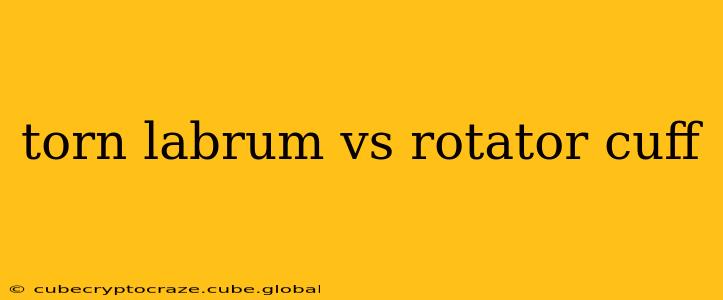Shoulder pain is a common complaint, often stemming from injuries to the labrum or rotator cuff. While both structures are crucial for shoulder stability and function, a torn labrum and a rotator cuff tear are distinct injuries with different causes, symptoms, and treatments. This comprehensive guide will clarify the differences, helping you understand your shoulder pain better.
What is a Torn Labrum?
The labrum is a ring of cartilage that surrounds the shoulder socket (glenoid). It deepens the socket, providing stability and enhancing the shoulder's range of motion. A torn labrum occurs when this cartilage is damaged, often due to a sudden injury like a fall or forceful impact. Repetitive overhead movements can also contribute to a tear over time. Think of it like a gasket—when it's damaged, the shoulder joint is less stable.
Types of Labral Tears:
Labral tears can be classified into several types based on their location and the nature of the tear. Some common types include:
- SLAP (Superior Labrum Anterior to Posterior) tear: This is the most common type of labral tear, affecting the upper part of the labrum.
- Bankart lesion: This involves a tear of the anterior (front) labrum, often associated with shoulder dislocation.
- Posterior labral tear: This type of tear occurs in the back part of the labrum.
What is a Rotator Cuff Tear?
The rotator cuff is a group of four muscles and their tendons that surround the shoulder joint. These muscles (supraspinatus, infraspinatus, teres minor, and subscapularis) help to rotate the arm, lift the arm overhead, and stabilize the shoulder. A rotator cuff tear occurs when one or more of these tendons are damaged, usually due to overuse, aging, or a sudden injury. Tears can range from small partial tears to complete tears where the tendon is completely severed.
Symptoms of a Rotator Cuff Tear:
Symptoms of a rotator cuff tear can include:
- Shoulder pain: Pain can be felt at the front, side, or back of the shoulder.
- Weakness: Difficulty lifting or rotating the arm.
- Limited range of motion: Inability to fully raise or rotate the arm.
- Clicking or popping in the shoulder: A palpable or audible sound with movement.
Torn Labrum vs. Rotator Cuff Tear: Key Differences
While both injuries can cause shoulder pain, there are key differences:
| Feature | Torn Labrum | Rotator Cuff Tear |
|---|---|---|
| Affected Structure | Cartilage ring (labrum) surrounding the shoulder socket | Tendons of the rotator cuff muscles |
| Common Cause | Sudden injury, repetitive overhead movements | Overuse, aging, sudden injury |
| Primary Symptoms | Instability, clicking, catching, pain with specific movements | Pain, weakness, limited range of motion |
| Diagnosis | Physical exam, MRI arthrogram | Physical exam, MRI, X-ray |
| Treatment | Physical therapy, surgery (in some cases) | Physical therapy, surgery (in some cases) |
What are the symptoms of a torn labrum?
Symptoms of a torn labrum can vary depending on the size and location of the tear. Common symptoms include:
- Shoulder pain: This can range from mild discomfort to severe pain, especially during certain movements.
- Clicking or popping: A noticeable sound or sensation in the shoulder joint during movement.
- Shoulder instability: A feeling that the shoulder is prone to slipping or dislocating.
- Limited range of motion: Difficulty lifting, rotating, or extending the arm.
- Catching or locking: A sensation of the shoulder catching or locking in place during movement.
What are the symptoms of a rotator cuff tear?
Symptoms of a rotator cuff tear are often similar to those of a labral tear, but can also include:
- Shoulder pain: This is a common symptom and can be severe.
- Weakness: A significant decrease in shoulder strength, especially when lifting or rotating the arm.
- Night pain: Pain that is worse at night.
- Atrophy: Loss of muscle mass in the shoulder area.
How are torn labrum and rotator cuff tears diagnosed?
Diagnosis of both conditions typically involves a physical exam and imaging studies, such as MRI or MRI arthrogram (for labral tears) and X-rays (for rotator cuff tears to rule out other problems). The physician will assess your range of motion, strength, and any pain or instability you experience. The specifics of the imaging help determine the severity and location of the injury.
How are torn labrum and rotator cuff tears treated?
Treatment for both labral and rotator cuff tears depends on the severity of the injury and the individual's symptoms. Options can include:
- Physical therapy: This is often the first line of treatment for both conditions, helping improve strength, range of motion, and stability.
- Medication: Pain relievers and anti-inflammatory drugs may be prescribed to manage pain and inflammation.
- Surgery: Surgery may be recommended for severe tears that don't respond to conservative treatment. Arthroscopic surgery is often used for both labral and rotator cuff repairs.
Disclaimer: This information is intended for educational purposes only and should not be considered medical advice. Always consult with a healthcare professional for any concerns about your health or shoulder pain. They can provide a proper diagnosis and recommend appropriate treatment options based on your specific situation.
